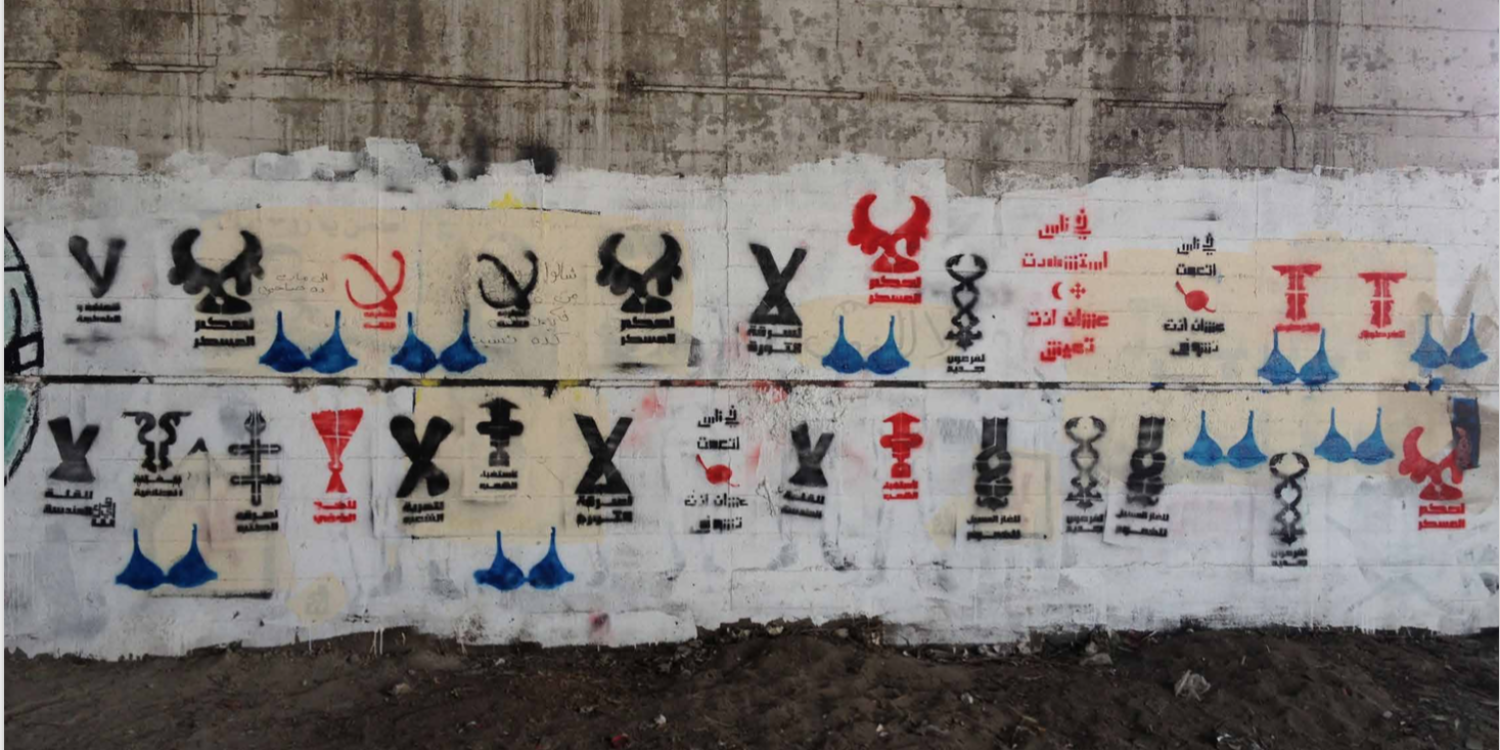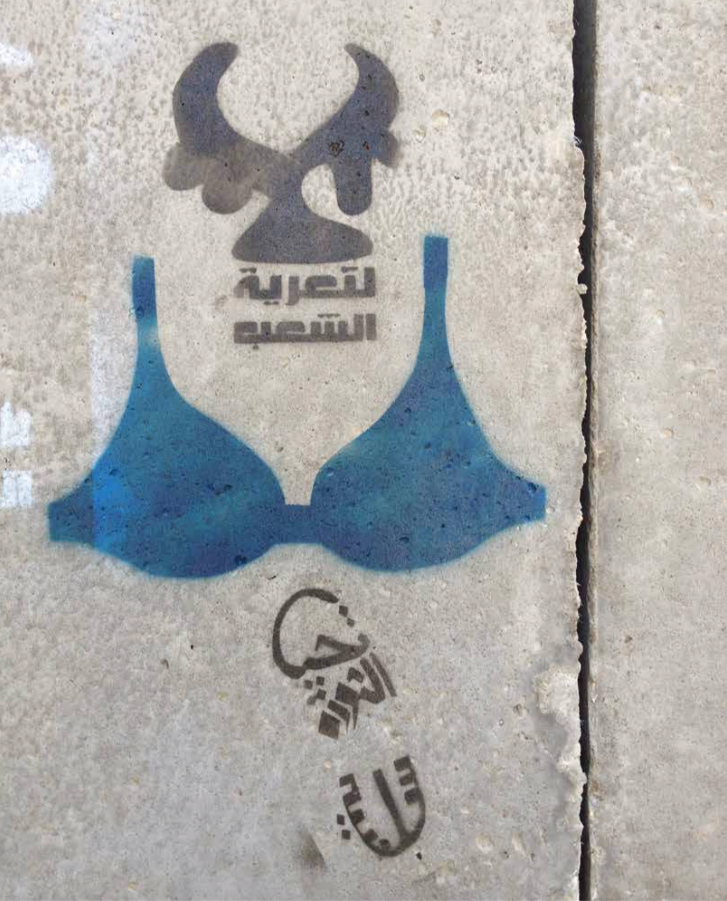Lebanese-Egyptian street artist, designer, and art historian Bahia Shehab’s latest book You Can Crush the Flowers: A Visual Memoir of the Egyptian Revolution documents the 18 days of the Revolution in 2011. Her book marks the ten-year anniversary of the revolution and tells the stories that inspired her own artwork and those of her fellow-revolutionaries. As an artist and activist, Bahia combines visual history, her own personal memoir and over 250 images to narrate the events of the revolution as they unfolded, witnessing the brutality of the regime while paying tribute to the protestors who bravely defied it. Projects and Communications Assistant Reem Hammoud spoke with Bahia to learn a little bit more about the putting together of her new powerful book.
1. How did You Can Crush the Flowers, A Visual Memoir come about? What was the writing and research process?
The research process started 10 years ago when I started documenting the Egyptian uprising from January 2011 – I was screenshot-ing, collecting data, practically playing historian. When I became active this documentation process kept going. Everything was filed. Then two or three years ago I started looking through my files and found I had 9000 images: screenshots of FB posts, links, memes – and I realized that I had all this data from then while the memory of the revolution was being systematically erased now. As an artist I am triggered by my visual memory, and seeing all of the images I had collected I felt an urgency to re-tell the story from my point of view. I started by filing the images by date and then sub-dividing them into themes. After drawing a historic timeline of events I started looking through my camera reels from the years of the revolution to also remind myself of the emotional context I was in. How old were my daughters? What were they doing? Who was with me at certain events? Where was I when an event unfolded? All this data was preserved on my reels. So after constructing a historic timeline of events and a personal one I started by matching the two and writing the story as I remember it from my material. I can only say one thing; there were a lot of tears – my editors can attest to that.
2. In the context of the Egyptian revolution, why do you think documentation is so important?
I felt it was important that I bring out my archive because I don’t have an official platform to share it on, I thought that maybe writing a memoir, a history from below, would be an accessible way for the general reader to learn more about the revolution; bearing in mind that now many of the younger generation in Egypt know very little about what happened only ten years ago. For the coming generations who know nothing about the revolution, we don’t have public archives or a museum for it, we don’t have the needed platforms for preserving and disseminating the memories, so the book for me is an accessible medium in which I can do so. It is a visual documentation and an emotional journey, a kind of a time capsule of what was happening then.
3. In You Can Crush the Flowers, you use memoir and over 250 images to paint a picture of the streets during the 18 days of the Revolution. Can you share a particularly memorable image from the book with us, and why?
The revolution was full of striking visuals and that is part of its mass appeal. The technology was now in the hands of many people and the citizen reporter became one of the unsung heroes of the uprising. It is really difficult to choose but if I have to I would say that the Blue Bra, to me, remains one of the most iconic images of brutal oppression against humans and specifically women. Tens of artists created artworks inspired by that incident of men dressed in military clothes stripping a woman of her black abaya and revealing her blue bra. Mass demonstrations by women all of over Egypt broke out the next day.
4. As a multi-disciplinary artist, you draw from a number of different cultural sources. Can you talk about some of your main influences and inspirations, both in You Can Crush the Flowers and in your street art as seen in At the Corner of a Dream?
To me the main cultural source for both books is the Arab world and Islamic culture. They are an important part of driving my visual language as an artist, and my inspiration and conceptual work in the arts. Aesthetically I appreciate the works of Samir Sayegh from Lebanon, Hassan Massoudy from Iraq, Rashid Koriachi from Algeria and Nja Mahdaoui from Tunisia.
5. Given that both of your books are published in English, who are they for and what do you hope readers take from your books?
The books are targeted at anybody who believes in social change, and they are published in English in order to make them accessible to the largest audience. They are documents that preserve a memory and share a personal experience. I think there was a lot of learning in what happened in Egypt ten years ago, and I hope it will be useful to others who are interested in social change, because then at least they can learn from our shortcomings.
6. Your street art in Cairo was in direct response to the Revolution, what made you decide to replicate your work in different parts of the world?
In 2013 Cairo was no longer accessible as a city to me. So I thought if Cairo is not accessible, then the cities of the world will be. This is why I started replicating ‘1000 x No’ specifically. ‘1000 x No’ started as an abstract concept and an artwork that was installed at the Haus Der Kunst in Munich in 2010, saying no to everything we feel is wrong in our life, and then it transformed into a direct response to the events that were unfolding in Cairo in 2011. Then when we travelled with ‘1000 x No’ it took on a new life and a new form, as a collective ‘No’ to the things that our collective humanity should by now be considering – no to borders, no to killing – so the specific concepts that were unfolding during the Revolution in Cairo, with the ‘No’s’ that were sprayed on the street became general messages of peace and coming together on this planet. The concept of the ‘No’ is what travelled to different parts of the world, and it acquired a life of its own.
7. In You Can Crush the Flowers, you categorise the 18 days of the Revolution into exhibition rooms. What made you do this and do you think there will be an in-person exhibition of the book?
I actually believed that we would create an exhibition about the Revolution – this began as a real proposal, not an abstract dream. I submitted it to a minister and we were planning on actually creating this exhibition – perhaps I should say I naïvely submitted it to a minister in this hope, and I was promised a space for it in one of the prominent museums. I was actually holding meetings in February and March of 2011 to create a museum, and an archive – little did I know. So that was the reason I thought of the exhibition. As for an exhibition of the book, I’m not sure if anyone now is interested in hearing about the Egyptian revolution or seeing an exhibition. I think it will still happen when the time is right, when somebody is interested in hearing about it.
8. The publication of You Can Crush the Flowers marks the 10-year anniversary of the Revolution. Looking back over these years, what lasting effects do you think the Revolution has had on Egypt today?
I don’t think we can really understand the repercussions of such a monumental event in one decade. I always felt it was going to take many decades for us to reap the results or the lasting effects. I speak from a personal point of view because I cannot generalize; and as I said, as a historian, we need time to look back. Until all the pieces of the puzzle fall into place you cannot really tell what the lasting effect will be. But for me on a personal level I think it connected me with like-minded people and at least now the people who believe in change know each other, we are out in the open. The idea that social change is possible is now a reality; the idea that it’s a process is also clear to me, because ten years ago I was preparing to create a museum after the Revolution, naively thinking that we were ready, and then you realize that with such big ideas it takes time until they trickle out, or become mainstream. So I think we always need to understand that such monumental events need a lot of time before we see a lasting effect, and we cannot predict that lasting effect – I cannot tell how this younger generation, who’s growing up now will react to events in their everyday life. A revolution is a process, it takes time and it’s in the mind. I cannot tell what the minds of this younger generation will do. Sometimes I feel that they know nothing and at other times I feel that they know everything. I am hopeful – and I think it’s that hope I want to hang on to. The revolution gave me purpose, and purpose is the most meaningful thing you can have in your life.
You Can Crush The Flowers: A Visual Memoir of the Egyptian Revolution is available now and published by Gingko Books.



